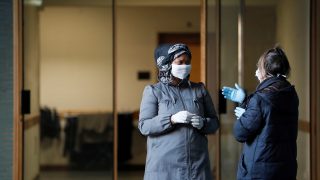Transcript
Hey, my name is Hadassah. I’m a staff writer for Ventures Africa. And today, I would like to tell you how the COVID-19 pandemic is affecting women and girls.
Initially, COVID-19 was labelled the ‘great equaliser’, the disease that is no respecter of class. However, it is turning out to be anything but that. The thing is, a pandemic magnifies all existing inequalities, be it social, economic, or gender inequality. Which is why in the past few weeks, the conversation surrounding COVID-19 has broadened: it has become clear that we are not just living through a public-health crisis, we are also living through a socio-economic crisis and the effects are harder on women. Here’s how:
1. Sexual and Gender-Based Violence(Shadow pandemic): Within the context of COVID-19, several factors are lending themselves to a heightened risk of violence for women and girls. Stress, alcohol consumption, and financial difficulties are all considered triggers for violence in the home, and the globally imposed quarantine measures have increased all three. Also, many women and girls are trapped at home with their abusers due to mandatory lockdowns.
Last month, the Coordinator of the Lagos State Domestic and Sexual Violence Response Team (DSVRT), Titilola Adeniyi, revealed that since the lockdown started, the number of domestic violence cases reported daily to her team has increased from eight cases daily to about 15 cases daily.
Speaking of GBV, there’s also the issue of female genital mutilation. Currently, Somalia is recording a surge in FGM. Circumcisers are going door to door offering to cut girls stuck at home. Girls that would otherwise be in school. Parents are also requesting that their daughters be circumcised since they are not in school.
Furthermore, the lockdown makes it difficult to raise awareness of the dangers of FGM in communities. The pandemic is also shifting world attention and funding away from tackling FGM. The UNFPA estimates 290,000 girls will be cut in Somalia this year.
In Argentina, femicide has reached a 10-year high under the coronavirus lockdown. More than 50 femicides in less than two months. At least 49 women were killed between March 20 and May 14 in Argentina, this year. The Thompson Reuters Foundation News reports that calls to Argentina’s emergency line for domestic abuse victims increased by two-thirds in April versus a year earlier.
2. Maternal mortality: More women are dying in childbirth because resources have been diverted elsewhere. There’s a distortion of health systems, everything goes towards the outbreak.
In Uganda, mothers in labour die amidst the Covid-19 lockdown. The government ban on private transport in place since March 30 does not make an exception for people with medical emergencies. The ban makes it hard for patients and health workers to reach medical centres.
Last month, a human rights group in the East African country told the Reuters News Agency that seven women in labour and two babies have died because they were forced to walk to the hospital to give birth. Primah Kwagala, head of a Pro Bono legal initiative for Ugandan women, cited six other reports of women who died in labour because they could not reach a hospital.
3. School closures and job loss: Globally, almost 70 percent of the world’s student population, about 1.1 billion children and young people are currently out of school owing to nationwide lockdowns, this is according to the United Nations Educational, Scientific and Cultural Organization (UNESCO).
These school closures particularly affect mothers because much of the responsibility of childcare falls on them. In cases where one parent has to quit or take time off work to be able to cater to the kids, it’s mostly women that forego their jobs. They are more likely to be the lower earners, so their jobs are considered a lower priority.
In developing countries, school closures affect a girls’ life chances more than they do boys. Girls face the perils of early marriage, early pregnancy, and abuse. 2019 figures from UNESCO show that 52 million girls are not in school in Africa. 4 million of them will never attend school, that’s compared to 2 million boys.
4. Health workforce disparity: Women comprise the majority of health and social care workers and are on the front lines of the fight against COVID-19. According to a health workforce report by the World Health Organisation, 70 percent of workers in the health and social care sector, are women. They also earn 11 percent less than men in the same field.
Early last month, perhaps late March, there was a tweet about COVID-19 affecting women more than it affects men. The replies to that tweet were disparaging. The general tone was, oh, here we go again, the feminists are at it again. Women always want to centre themselves.
This is not about women centring themselves. It’s about existing inequalities and how a crisis exacerbates them. So, as you now know, thanks to me, COVID-19 does not discriminate, it doesn’t affect all parts of society equally.
Like the UN Secretary-General, Antonio Guterres, said last month, it is crucial that governments take the needs of women into account in their response to the pandemic. Stakeholders are advised to develop a gender-responsive strategy to deal with the fall-out of the COVID-19 crisis.








